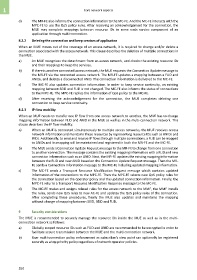Page 360 - 5G Basics - Core Network Aspects
P. 360
1 Core network aspects
d) The MR-FE also informs the connection information to the MC-FE. And the MC-FE interacts with the
MPC-FE to use the QoS policy rules. After receiving an acknowledgement for the connection, the
MUE may complete mappings between resource IDs to serve each service component of an
application through multi-connection.
8.2.2 Deleting the connection and keep services of application
When an MUE moves out of the coverage of an access network, it is required to change and/or delete a
connection associated with the access network. This clause describes the deletion of multiple connections in
the MUE.
a) An MUE recognizes the detachment from an access network, and checks the existing resource IDs
and their mappings to keep the services.
b) If there is another connected access network, the MUE requests the Connection Update message to
the MR-FE via the connected access network. The MR-FE updates a mapping between a FLID and
ANIDs, and deletes a disconnected ANID. The connection information is delivered to the MC-FE.
c) The MC-FE also updates connection information. In order to keep service continuity, an existing
mapping between SEID and FLID is not changed. The MC-FE also informs the status of connections
to the MPC-FE. The MPC-FE replies the information of QoS policy to the MC-FE.
d) After receiving the acknowledgement for the connection, the MUE completes deleting one
connection to keep service continuity.
8.2.3 IP flow mobility
When an MUE needs to transfer one IP flow from one access network to another, the MUE has to change
mapping information between FLID and ANID in the MUE as well as in the multi-connection network. This
clause describes the IP flow mobility.
a) When an MUE is connected simultaneously to multiple access networks, the MUE receives access
network information and maintains these resources by representing resource IDs such as ANIDs and
IFIDs. Additionally, to send and receive IP flows through multiple connections, a FLID can be mapped
to ANIDs and its mapping will be maintained and registered in both the MR-FE and the MC-FE.
b) The MUE sends a Connection Update Request message to the MR-FE to change from one connection
to another connection. The message contains the existing mapping information with a FLID and new
connection information such as an ANID. Next, the MR-FE updates the existing mapping information
between the FLID and new ANID based on the Connection Update Request message. Then the MR-
FE sends a Connection Information message to the MC-FE including updated mapping information.
c) The MC-FE sends a Transport Resource Modification Request message which contains updated
information of the connections to the MPC-FE. Then the MPC-FE selects new QoS policy rules for
the connection based on the operator policy and the updated connection information. Finally, the
MPC-FE returns a Transport Resource Modification Response message to the MC-FE.
d) The MC-FE makes and assigns related rules for the access network to the MMF, the MMF installs
the rules, sends new QoS rules to new AC-FE and updates the QoS policy rules of the connection.
After completing these procedures, finally the MUE also updates and maintains the mapping
without change of mapping between SVID, SEID and FLID.
9 Security considerations
The MUE is recommended to securely manage the resource IDs inside the MUE as well as in the multi-
connection network as follows:
a) Globally scoped resource IDs such as FLID and ANID are recommended to be encrypted in order to
facilitate secure transmission between the MUE and the multi-connection network.
b) User multi-connection policy enforcement as subscriber's view point can optionally be registered
securely as a top priority policy regardless of network operator policies.
350

